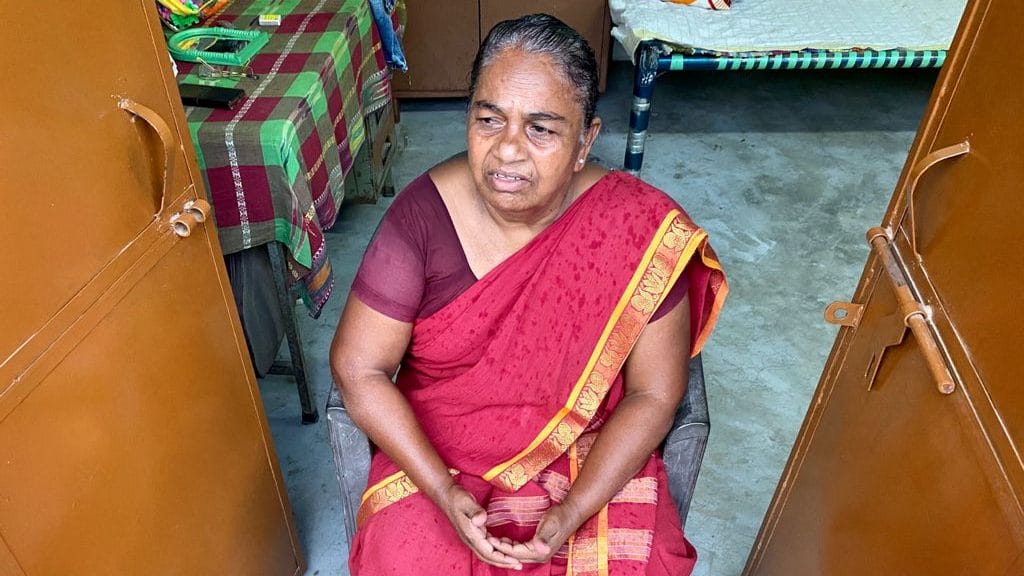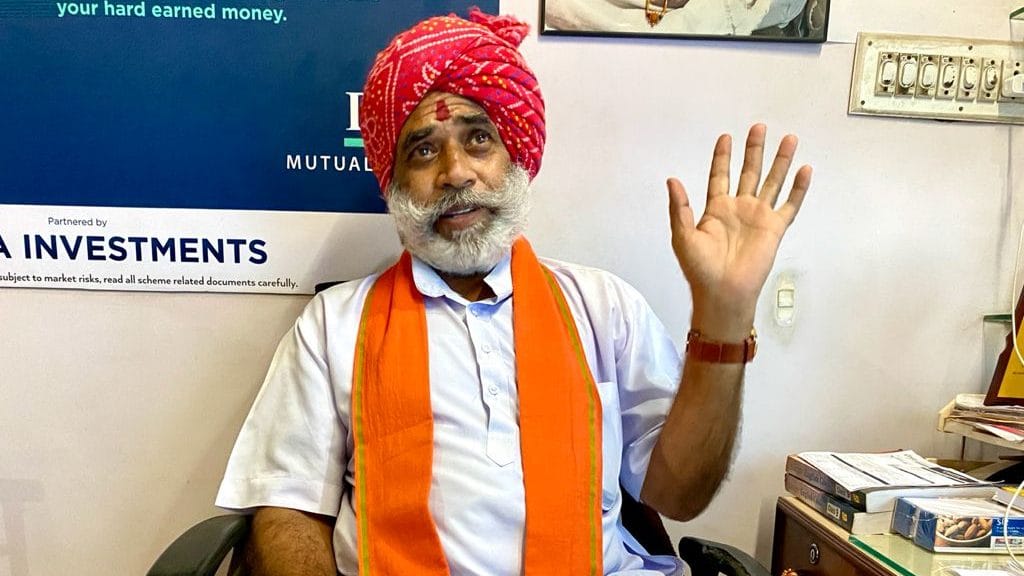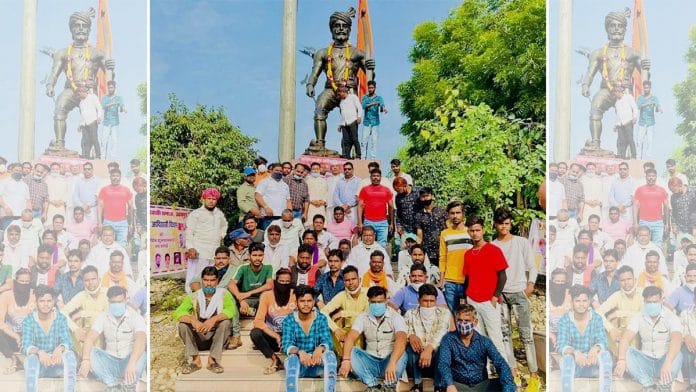Udaipur: Warrior, leader, icon of our legacy — this is how Bhils, a tribal community in Rajasthan, describe the 16th century warrior Rana Punja Bhil.
Bhil, also known as Bhilu Rana, was a commander in the then Mewar ruler Maharana Pratap’s army, and notably was present at the Battle of Haldighati against forces of Mughal emperor Akbar.
Centuries on, his legacy has sparked a tussle between the tribal Bhil community and various Right-wing Hindu outfits.
The acrimony owes its genesis to events that transpired on 9 August, observed as World Adivasi Diwas.
To mark the day, members of Right-wing groups hoisted a saffron-coloured flag on the statue of Rana Punja Bhil, located at the popular Reti Stand chauraha in Udaipur.
This led to protests from adivasi outfits, whose members allege that the BJP and RSS were behind it as a way of “appropriating Rana Punja Bhil”.
They even lodged a police complaint that has led to an FIR against BJP leaders, including former councillor Bheru Lal Meena.
Since then, it has led to a slanging match on cultural appropriation, imposition of Hinduism and erasure of histories.
BJP councillor Meena, however, told ThePrint that it was “local people” who had only hoisted a “kesariya flag”, which he added was symbolic of Mewar and particularly of Maharana Pratap’s empire.
But this is the second major clash between adivasi outfits and Hindu Right-wing organisations over questions of legacy and identity. ThePrint had earlier reported that just weeks earlier, a similar controversy had erupted over the Amagarh Fort in Jaipur.
The catalyst was once again a saffron flag hoisted on the fort’s ramparts that led to a furore among many members of the tribal Meena community, who brought the flag down.
Also read: RSS affiliate to make tribals aware of ‘Hindu identity’ with stories from Ramayana, Mahabharata
‘Tomorrow they will put bhagwa flag on Gandhi too’
The Akhil Bharatiya Adivasi Mahasabha alleges that BJP leaders and workers hoisted the bhagwa or saffron flag on the warrior’s statue on 9 August, despite their protests.
“We tried to stop them but they went ahead with it anyway. We then argued over it, but they didn’t listen,” Suresh Meena, the Udaipur secretary of the outfit, told ThePrint.
Meena said that by hoisting a saffron flag on the statue, the BJP was attempting to appropriate the leader.
“This is what they keep doing; they keep hoisting bhagwa flags everywhere. Tomorrow, they will go and hoist a bhagwa flag on a Mahatma Gandhi statue as well, and call him their own. That’s unacceptable,” he said, adding that the statue is not a religious site, and hence is no place for a saffron flag.
While the Bhils and Meenas are two separate tribal communities in other parts of Rajasthan, in Udaipur and other Mewar regions, they are categorised as one.
Sadhna Meena, national leader of the Adivasi Mahasabha, said there was a larger issue, in that the “RSS’s ideology and adivasi culture are against each other”.
“The RSS wants to impose its ideologies on us. But we don’t consider ourselves Hindus to begin with. We are adivasis and identify as just that,” Sadhna told ThePrint.
“There are some adivasis who are part of the BJP and RSS. But one day they too will have to face the community’s questions,” she added. “The BJP won’t give their dead bodies a shoulder, only the adivasis will.”

‘Not bhagwa, but kesariya Mewar flag’
BJP leader and former councillor Bheru Lal Meena, who has been named in the FIR, insisted that his party had nothing to do with it.
The FIR, accessed by ThePrint, has been registered under the IPC Sections 341 (punishment for wrongful restraint), 323 (punishment for voluntarily causing hurt) and 143 (unlawful assembly).
Lal Meena told ThePrint that the samaj or community hoisted the flag.
“This has nothing to do with the BJP or RSS. The people present there, the samaj, wanted this flag to be hoisted,” Meena told ThePrint.
Moreover, he insisted that it wasn’t a bhagwa flag, but a kesariya one that is a part of Mewar’s history.
“The flag had Jai Mewar written on one side and Rana Punja Bhil’s name written on the other. So how can it be a bhagwa flag; this is a wrong accusation,” he said.
The Udaipur Police maintains that the investigation is still ongoing.
“The case is being investigated; no arrests have been made so far,” Nana Lal, the investigating police officer on the case, told ThePrint.
Tribals are Hindus, will always be Hindus: BJP
On the greater accusation of “imposing Hinduism” on tribals, Bheru Lal Meena said it is impossible as “he is a tribal himself”.
“I am a tribal, the MLA here is tribal, the MP is tribal. How can they accuse us of these things?” he asked. “Moreover, how can we not be Hindus? Our predecessors have been worshipping Shiva since time immemorial.”
The BJP MLA of Udaipur Rural, Phool Singh Meena, told ThePrint that there is no question of imposing Hindu identity on Adivasis as “both are the same”.
“Hum Hindu the, hain, aur rahenge (We were, are and will always be Hindus),” he said.
“All the people here are part of the Hindu culture and believe in it, so there is no question of us not being Hindus,” he added.
The Congress government has so far not spoken on the issue, and is maintaining a distance from it.

Bhil next to Pratap in Mewar flag, shows contribution: Experts
Experts say the fight over Rana Punja Bhil’s legacy isn’t new, but his importance is “indisputable”, especially given the fact that the Mewar symbol has both Maharana Pratap and Bhil.
Lokesh Paliwal, who works on culture and history with UNESCO, and who directed a documentary on Rana Punja Bhil in 2019, said there is some dispute over the warrior’s background.
“Some say that he was actually a Rajput himself but only commanded an army that mostly consisted of Bhils. But many other historians believe that he was a Bhil himself as that explains how he enjoyed such great respect and following among members of that community back in the day,” Paliwal said.
Rana Punja Bhil led Maharana Pratap’s forces alongside him in various battles, and deserves much credit, Paliwal added.
“Maharana Pratap was left with no option but to accept the help offered by Punja. Rana Punja Bhil was able to train regular people and led that army to fight as part of Pratap’s forces,” he said.
According to Paliwal, the Maharana too recognised Punja’s contribution, and he was thus given the title of ‘Rana’ after the battle. The Mewar symbol too subsequently had Maharana Pratap and Rana Punja Bhil next to each other.
The adivasi outfits use this as evidence to highlight his importance.
“All this shows the importance and contribution of Punja in history. He is the one who not only prepared his forces, but also ensured everything was ready for the battle: the food, the horses, everything,” Sadhna Meena said.
(Edited by Arun Prashanth)
Also read: Social, cultural habits are preventing spread of Covid among India’s tribals, survey finds






